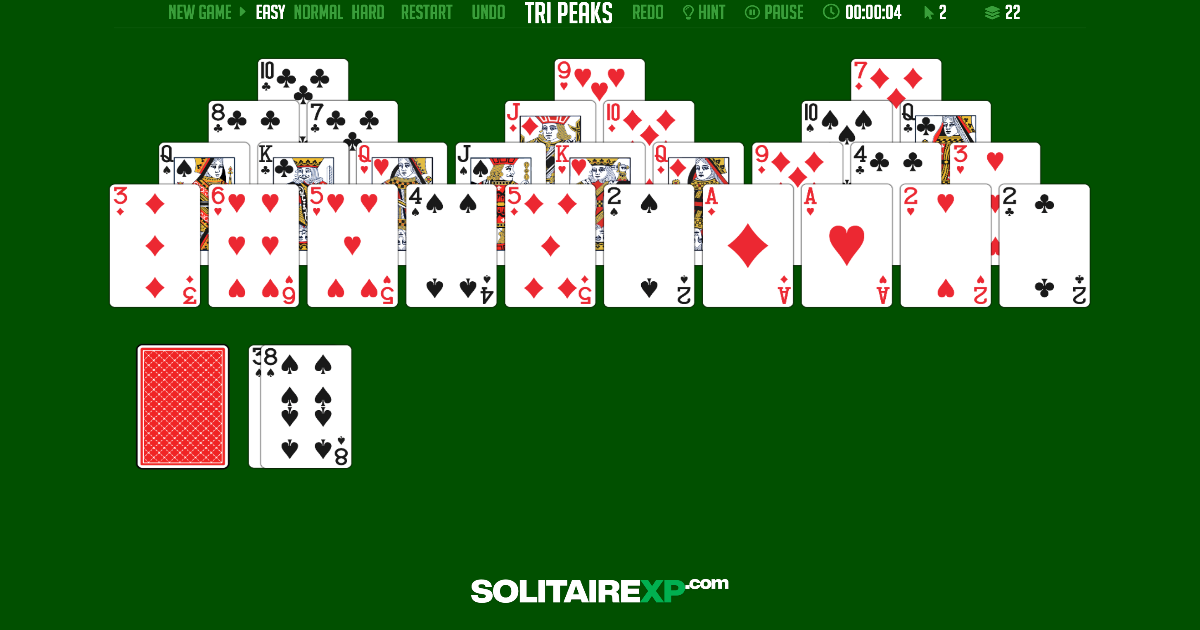What is Spider Triple Solitaire?
Spider Triple Solitaire is an advanced variation of the classic Spider Solitaire game, played with three full decks of cards (156 cards). The primary objective remains the same: build complete descending sequences from King down to Ace in the same suit. Because the game uses three decks, gameplay is longer, the tableau is larger, and the strategic depth increases significantly compared to 1-suit, 2-suit, or 4-suit Spider Solitaire.
This version suits experienced players who enjoy complex decision-making, multiple-move planning, and a challenging puzzle-style experience with high replayability.
How to Play Spider Triple Solitaire
🎴 Set Up
Spider Triple Solitaire (also called Spider 3-Deck or Triple Spider) is played with three standard 52-card decks — that’s 156 cards in total! You’ll deal 54 cards face-down into 12 tableau piles (some piles get 5 cards, others 4), with only the top card of each pile face-up. The remaining 102 cards form the stock pile in the corner. Ready? Let’s shuffle and deal! ♠️♥️♦️♣️
🏆 Objective
Your goal is to build 12 complete suits from King down to Ace (K-Q-J-10-9-8-7-6-5-4-3-2-A) in the tableau itself. Once a full suit is assembled in the correct order, it’s automatically removed from play. Clear all 12 suits and you win the game! 🎉
🔄 How to Move
You can move any face-up card (or properly sequenced group of cards) onto another card that is one rank higher, no matter the suit or color — this is what makes Triple Spider more flexible (and fun!) than classic Spider. Empty piles can be filled with any card or sequence. When you’re stuck, click the stock to deal one card face-up to each of the 12 piles. Keep building descending sequences and uncovering hidden cards! 🃏
🎊 Winning
The game is won when all 12 full suits (King through Ace, same suit) have been built and removed from the tableau. It’s a challenging puzzle that rewards patience and planning — but when that last suit disappears, the victory feels amazing! 🏅
Rules of Spider Triple Solitaire
- The game uses three standard 52-card decks (156 cards total).
- You can move single cards or correctly ordered sequences between columns.
- Only sequences composed of the same suit can be cleared and removed from play.
- New cards may be dealt only when no tableau column is empty.
- Empty columns can accept any single card or valid sequence and are key to reorganizing the tableau.
- The player wins when all King-to-Ace same-suit sequences are completed and removed.
Tips and Strategies
Use the strategies below to increase your chances of success in Triple Spider:
- Prioritize same-suit stacks. Focusing on same-suit runs makes it possible to clear sequences more reliably.
- Keep columns open. Clearing columns early provides space to maneuver large sequences.
- Avoid dealing new cards prematurely. Fill gaps and uncover face-down cards before drawing from the stock.
- Uncover face-down cards quickly. More face-up cards equal more available moves.
- Move Kings to empty columns. This creates fresh anchors to build new sequences.
- Think several moves ahead. Successful Triple Spider play often depends on long-term planning and staged sequences.
Difficulty Levels Explained
Spider Triple Solitaire ranks as one of the most difficult Spider variants. With three decks, the number of cards increases to 156, the tableau becomes larger and more cluttered, and opportunities for clean same-suit sequences are rarer. This creates longer games where planning and patience are essential.
Additionally, you can increase the difficulty by choosing other variations within the game itself like: 1-suit, 2-suits, 4-suits.
Triple Spider vs. Classic Spider: What’s the Difference?
While both variants share the same core mechanic—building descending sequences and clearing same-suit runs—the differences are significant:
- Deck count: Classic Spider typically uses 1 or 2 decks (52 or 104 cards), while Triple Spider uses 3 decks (156 cards), increasing complexity and game length.
- Tableau size: Triple Spider presents a much larger tableau with more overlapping cards and hidden information to manage.
- Difficulty: Triple Spider is considerably harder; classic Spider (especially 1-suit) can be approachable for beginners, but Triple Spider targets advanced players.
- Strategy changes: In Triple Spider, long-term planning, careful use of empty columns, and conservative dealing are far more important than in classic Spider.
- Replay experience: Triple Spider often produces longer, more puzzle-like sessions with high replayability for strategy-focused players.
Why People Love Spider Triple Solitaire
Fans of the variant praise its deep strategic play, satisfying long-term goals, and the mental challenge it provides. It’s an ideal choice for players seeking an intense solitaire puzzle that rewards careful planning and skillful reorganization of the tableau.
FAQs About Spider Triple Solitaire
Is Spider Triple Solitaire harder than regular Spider Solitaire?
Yes — significantly. The extra decks increase card volume and reduce the ease of completing same-suit runs.
Can I win without using empty columns?
Almost never. Empty columns are crucial for moving large sequences and reorganizing the tableau.
Is Triple Spider suitable for beginners?
No — beginners should master 1-suit or 2-suit Spider before attempting Triple Spider.
Are all suits required to complete?
Yes — to win, you must form and clear full same-suit sequences for all cards.
Does Triple Spider follow the same basic rules as classic Spider?
Yes, but the triple-deck layout aps complexity and length to the game.




Comments (0)